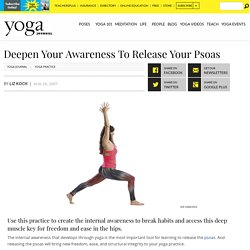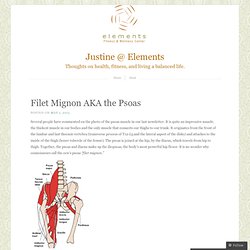

Yoga Anatomy - Release Your Psoas. Use this practice to create the internal awareness to break habits and access this deep muscle key for freedom and ease in the hips.

The internal awareness that develops through yoga is the most important tool for learning to release the psoas. And releasing the psoas will bring new freedom, ease, and structural integrity to your yoga practice. It can be difficult at first to access the subtle sensations of the psoas. Buried in the body, engaged in habitual patterns of holding (especially when you’re sitting or standing), and deeply linked to your emotions, the psoas is best approached with quiet attention, patience, and perseverance. Awareness is the first key.
Constructive Rest Position Rather than trying to instantly correct all the imbalances and habitual compensations you’ve developed throughout your life, we’ll begin by simply releasing the psoas in a posture called constructive rest position. Now that you’re in position, shift your awareness to the support of your bones. Delicious Psoas Stretch For The Holidays - Core Awareness. Lengthening Iliopsoas. Specific exercises for each of the alignment problems discussed in this chapter are readily available elsewhere.

However, I have found that information on two areas seems to be limited or erroneously covered in popular sources. The first area is the lengthening of the iliopsoas, and the second is toe touching. The stretching of the iliopsoas is probably the most neglected area of possible difficulty. Few people have ever heard of this muscle, although it contributes to countless backaches every year. The iliopsoas is attached to the inside of the vertebral column in the region of the lower back (lumbar area), passes over the front of the bony pelvis, and then runs downward and attaches to the inside of the upper leg bone (femur).
Here are three exercises that can be used to help keep the iliopsoas muscles lengthened: Flattening the small of your back while lying flat: Try to keep your thighs (iliopsoas attachment) on the floor while attempting to hold your lower back on the floor. How to stretch the psoas......myofascially! Tight Iliopsoas and Lower Back Pain.mp4. Psoas Massage-A New Gentle approach Part 2 of 2.mov. Filet Mignon AKA the Psoas. Several people have commented on the photo of the psoas muscle in our last newsletter.

It is quite an impressive muscle, the thickest muscle in our bodies and the only muscle that connects our thighs to our trunk. It originates from the front of the lumbar and last thoracic vertebra (transverse process of T12-L5 and the lateral aspect of the disks) and attaches to the inside of the thigh (lesser tubercle of the femur). The psoas is joined at the hip, by the iliacus, which travels from hip to thigh. Together, the psoas and iliacus make up the iliopsoas, the body’s most powerful hip flexor. It is no wonder why connoisseurs call the cow’s psoas “filet mignon.” For the expert athlete and the regular exerciser it is very important to keep this powerful muscle in tune. Sitting for long hours can be just as destructive for the psoas. As you can see a weak or overworked psoas can wreck havoc on your spine. If the thigh on the floor lifts up, then you have a tight psoas. Like this: Like Loading...